Hi agents, it’s Zi here!
After a week of chaos within our secret service office, we finally called a ceasefire and agreed on a new version of the game. No agents were physically harmed in the process. In this log, I’ll go over the problems we had the past week, Agent Bradley will take over to introduce the new version of the game, and of course, we’ll wrap up our log with our genius artist Sam sharing his amazing art updates.
Version Tested
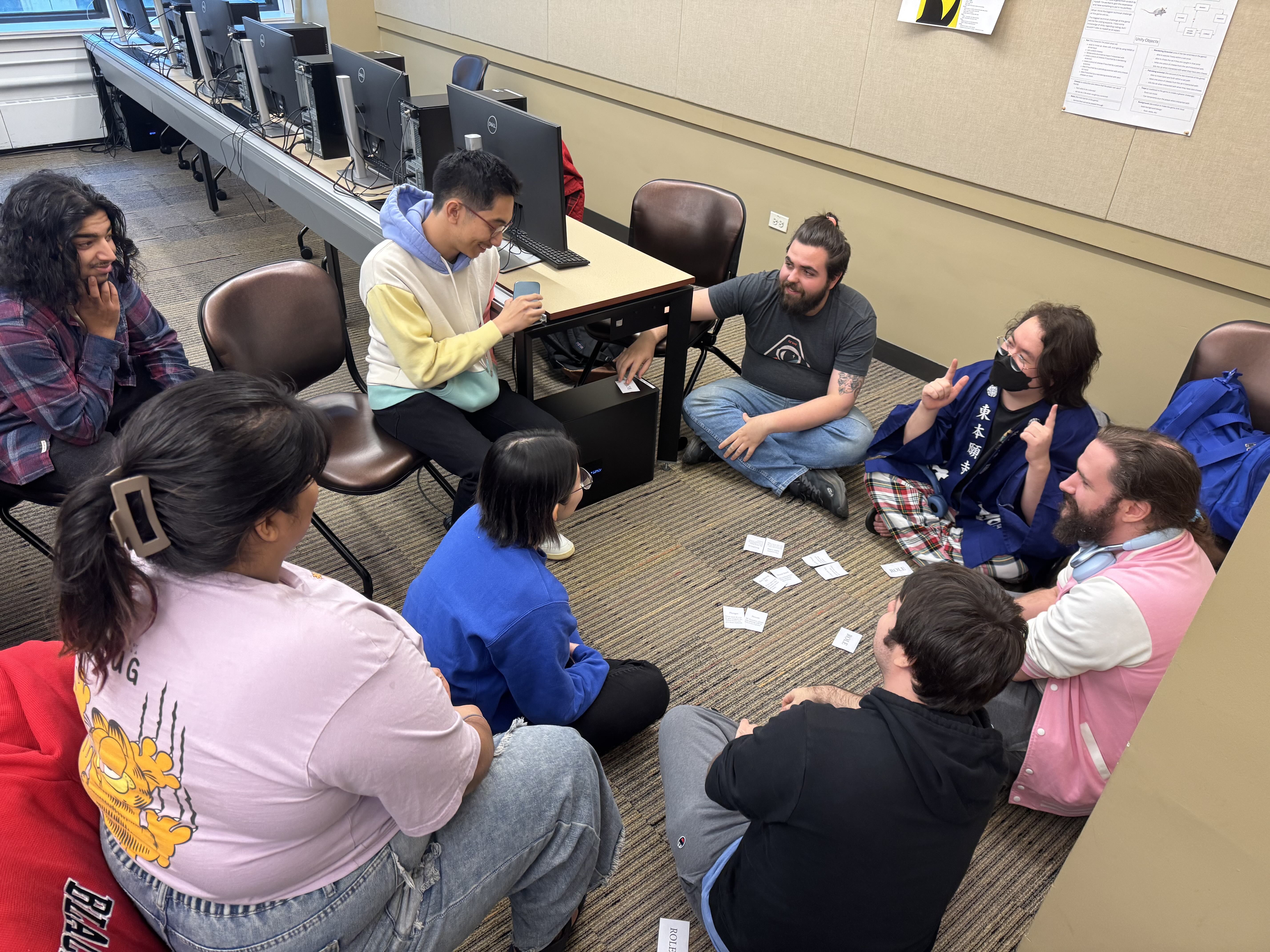
Classmates playtesting MPD in class
While we thought we had finally figured out the gameplay by inserting a discussion and adding a scripted line at the start of the action round, our Director of the Secret Service, Richard, delivere…
Hi agents, it’s Zi here!
After a week of chaos within our secret service office, we finally called a ceasefire and agreed on a new version of the game. No agents were physically harmed in the process. In this log, I’ll go over the problems we had the past week, Agent Bradley will take over to introduce the new version of the game, and of course, we’ll wrap up our log with our genius artist Sam sharing his amazing art updates.
Version Tested

Classmates playtesting MPD in class
While we thought we had finally figured out the gameplay by inserting a discussion and adding a scripted line at the start of the action round, our Director of the Secret Service, Richard, delivered the unfortunate news that we still need to decide if the game should lean into social deduction. This is where our opinions were torn. With only two of us in class that day, we decided to wait until the whole team is present to figure out the game’s direction.
In the meantime, we gathered some classmates in class to test out what we had of the game. In this version, the secret service knows who the president is, but they have no clue who the other secret service agents are, and the president doesn’t know anyone’s roles. The game core loop stayed the same, but players now have the chance to discuss their suspicions after the first round. Also, during the action phase, they have to start their descriptions with the line “As a secret service, I’m doing [action] because I think [player] is [role].” With these changes, we wanted to see if we could find a balance between social deduction and the absurdity of the game.
From the feedback we got, this version was… okay, but the discussion and the scripted action line did not have the impact we were hoping for. This made us question the whole social deduction aspect of the game. After some slightly dramatic debate, we decided to wait until the full team was assembled to finalize the rules, and this leads us to the next section.
Moving Forward - The Core Experience
Hi gamers, Bradley here! Looks like the HR department (us) did some restructuring, and as a result had to do some layoffs (change some of the rules), but don’t worry, Mr. President Duck! is still the same old silly little game at it’s core. But what is that exactly? Even we didn’t come to an agreement on that at first.
The core experience (in my opinion) is the feeling that you want players to have while playing the game. It should usually be summed up in one sentence. And delivering the core experience of a game is often a tricky one. Do you want players to feel a bit panicked and that the future of the world rests in their hands like in Pandemic or Daybreak? Do you want players to feel satisfaction in both building up and activating a chain of abilities like in Wingspan? Do you want players to feel sneaky and put on their best poker face as they try to hide their true intentions like in Coup? Or do you want players to feel cathartic and comedic relief of their frustration when solving a puzzle in Décorum? Do you want players to feel bored while playing combat like in Dungeons and Dragons? Even if you know what your game’s core experience, it can be easy to lose sight of that when adding new mechanics/rules or expanding upon existing ones.
Let’s take a moment to look at the now old version of the game. As it stood there were two main elements that our group cared about: (1) being funny in using non-lethal items in lethal ways and (2) people trying to figure who was who. Of course, it’s a bit tricky trying to balance these two things with the old versions of the rules. As Agent Zi mentioned previously, we had lean into a direction lest we run the risk of MPD having an identity crisis and pull the game in two different directions in terms of balance, or rework the game entirely if we wanted true social deduction. According to the timeline, that’s not something we can afford to do. And so we needed to decide which part of the game (the experience) we wanted to elevate for our players. Based off the data from internal playtesting and external playtesting, our group (peacefully) came to an agreement that what mattered in MPD was the improv and absurdity of trying to assassinate people with items. That collective laughter within the (magic) circle of people is truly an amazing experience and amazing to witness. Even if you did end up losing, it didn’t necessarily feel bad (at least to me) that you lost because the person that killed you or one was just funnier, and you could respect that. So there’s our core experience: we want players to amuse and entertain each other through the absurdity of their improv and actions based on what they have to work with. Which means, we want them to be funny!
Now that our team has come to an agreement on what the core of our game was, that helped us narrow our focus on the experience we care about and want to deliver to the players and take a big step back on how our game currently works (which is funny because we’re narrowing in on a thing but in order to do that we need to look at the bigger picture okay you know what I mean I hope that was funny please laugh or the HR department will come after me). Director Richard gave us some good suggestions on how we can shift the game such as adding points and giving different roles different point values based on who they killed and leaning into the absurdity of roles (at the potential risk of sacrificing role deduction) by giving roles special abilities. Honestly that seemed a bit intimidating at first to try and introduce but we later made a breakthrough. Here’s a picture of the adjusted our team agreed on at the end of the meeting and I’ll highlight several important changes:
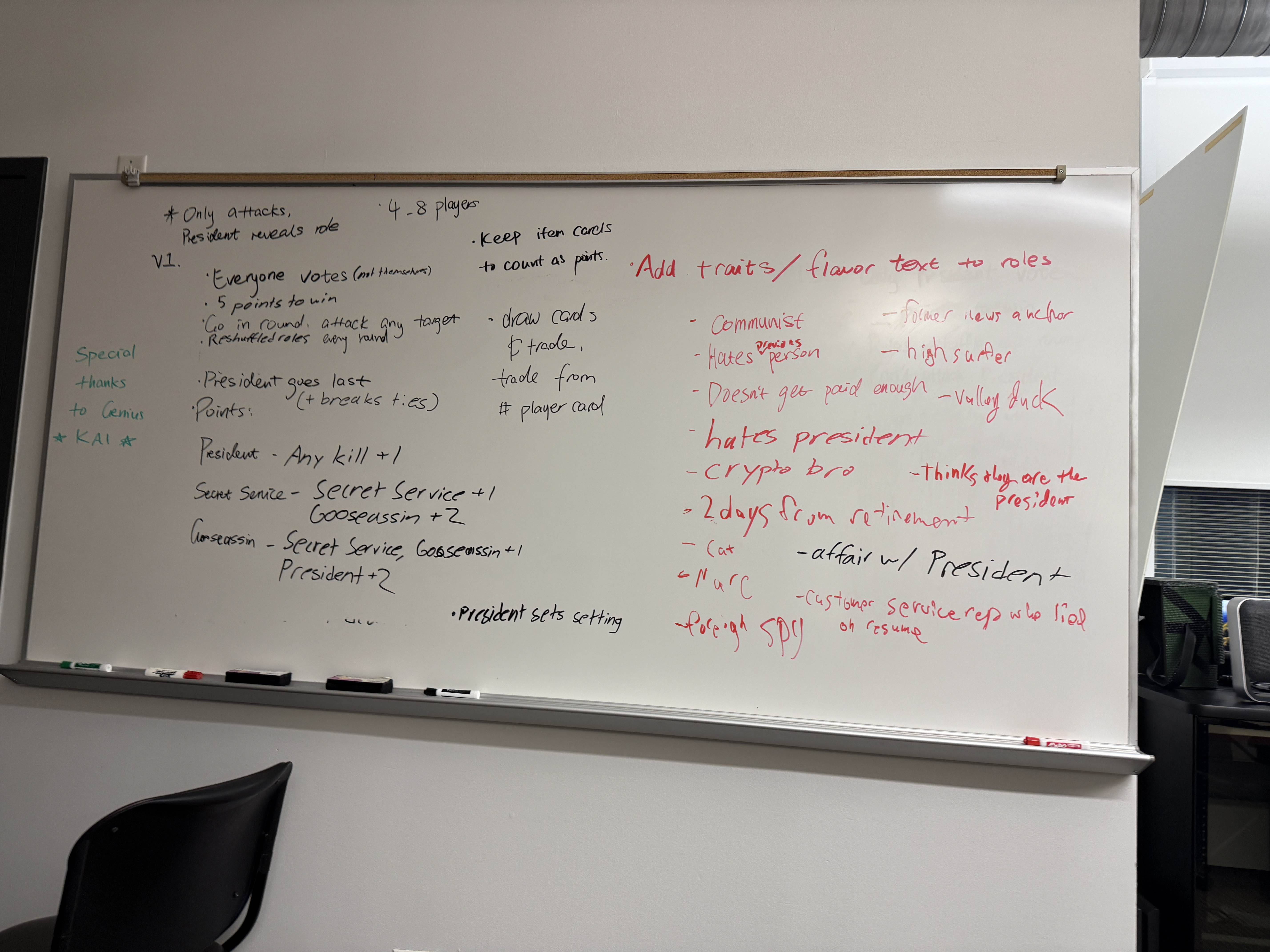
New rules for Mr. President Duck and trait ideation.
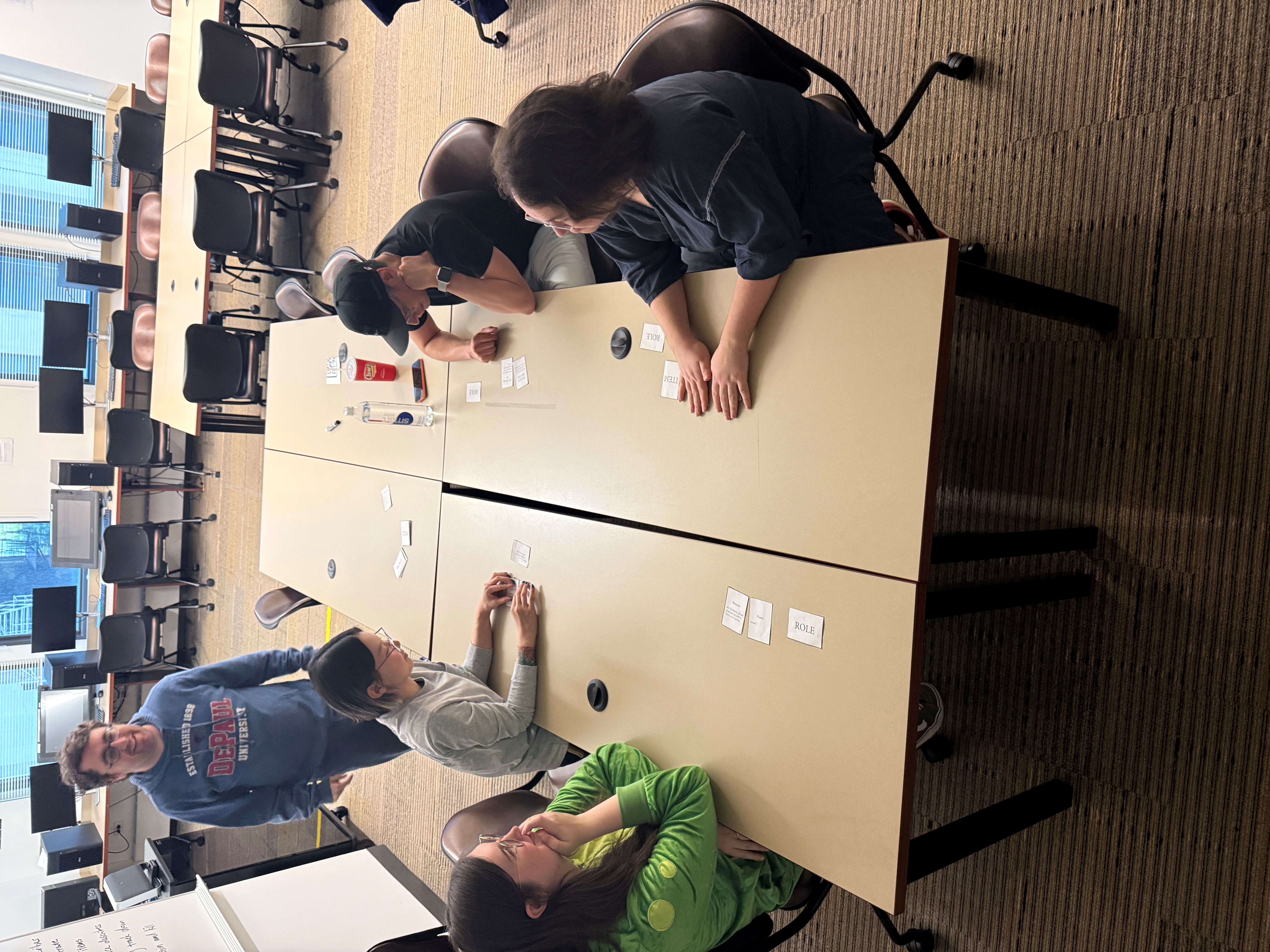
Experimenting with rules with playtesters for Mr. President Duck
During our ideation of how to change the rules, we went forward with the point system and “x amount of points to win” but kept the amount of points needed small so that the game was still fast, and decided that roles get reshuffled every round to prevent downtime of dead players. Furthermore, we decided on making Mr. President the only public role in game and that players go around in the circle (with Mr. President going last) describing how they Attack a target of their choice and removing Defenses entirely (you know what they say, the best defense is a good offense). We still wanted roles to matter and give players direction with slight role deduction, and they still do by giving the Secret Service and Gooseassin role incentive to target specific players. It doesn’t matter who Mr. President targets because the president doesn’t care, they just want to get the job done no matter what it takes. The Gooseassin is now placed in this interesting risk vs. reward position. As players go around in a circle talking about who they target, depending on where the Gooseassin player is in a circle, they can play it safe by targeting a Secret Service player and “blend in”, or if they’re lucky and are one of the last players to go, to go they can target Mr. President. And if they’re funny, well that’s that. That’s where that little bit of role deduction comes in, because the Secret Service will not gain any points if they target and kill Mr. President. So there will be shock, but there will also be laughter! Of course, if they’re one of the first to go they could target Mr. President and if they’re funny could still win, but now the Secret Service players know who to target and will most likely target that player. Overall, making these changes, on a large scale at least, shifts focus away from players focused on trying to figure out who’s who, because the Gooseassin will just end up exposing themselves...or would they?
It still felt like something was missing however. The setting and premise of the game was already a bit absurd after all, so we needed something to push that absurdity further. Since our focus is on player driven humor, we needed to encourage that more. In playtesting, the emergent storytelling aspect of players attacking each other existed to a degree, but by going around in a circle, it felt more cohesive. It made sense establish in the rules that the president would set the scene. Both in observations and in hearing feedback, players were acting in certain ways or taking on different personas based on what they had on hand. I then remembered the game Elon Musk’s iPod Submarine. It’s similar to Jackbox’s minigame, Fakin’ It, where everybody is aware of a prompt except for one player and have to try and blend in. In the story of our game, our Gooseassin is already doing a very bad job of that by wearing Groucho glasses. Why not take it one step further and assign different traits to different secret service players, highlighting how out of place the Gooseassin is, unaware of how truly wacky they are? Or maybe the Gooseassin will pick up on what’s going on around them and act out in an absurd way too. Plus, coming up with traits/prompts of how Secret Service players should act is easy enough (and Sam doesn’t need to do more art than they already need to). With this addition, certain traits now blur the lines of who’s who once again because while a player who has the trait of “hates the president” has no mechanical incentive to target the president, they have a narrative reason to. Whether they play into that or not is up to the player.
The good news about this version is that we would only need to minimal changes to story we have for the game and we still have some semblance of role deduction (now to the point of absurdity). We also have some flexibility of rules variants such as needing a smaller amount of points to win or roles only getting reshuffled when the Gooseassin or President dies. Before we did fully decided this was the right direction for our game, we did very briefly try another version of the game.
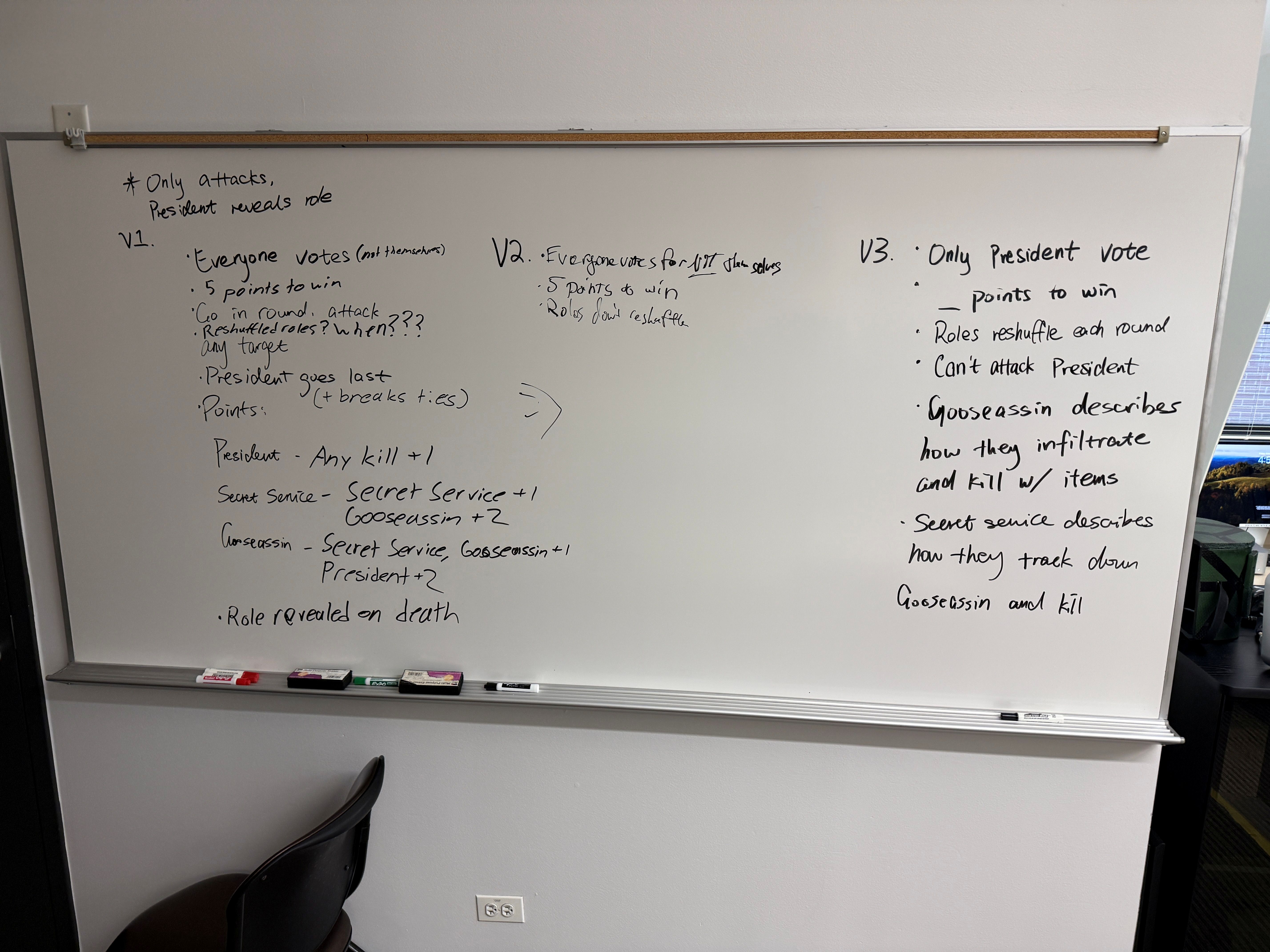
The Secret Service Team attempting to come up with different rules variants to playtest with.
Going back to the ideation stage, we did test what was labeled as “V3”. Unfortunately, V2 fell to the wayside as it was just a slightly variation to V1 and we ended up focusing on and making small adjustments to V1 as we went along. This version just has the President acting as the judge, hearing how they would try to assassinate a person but not the president directly.
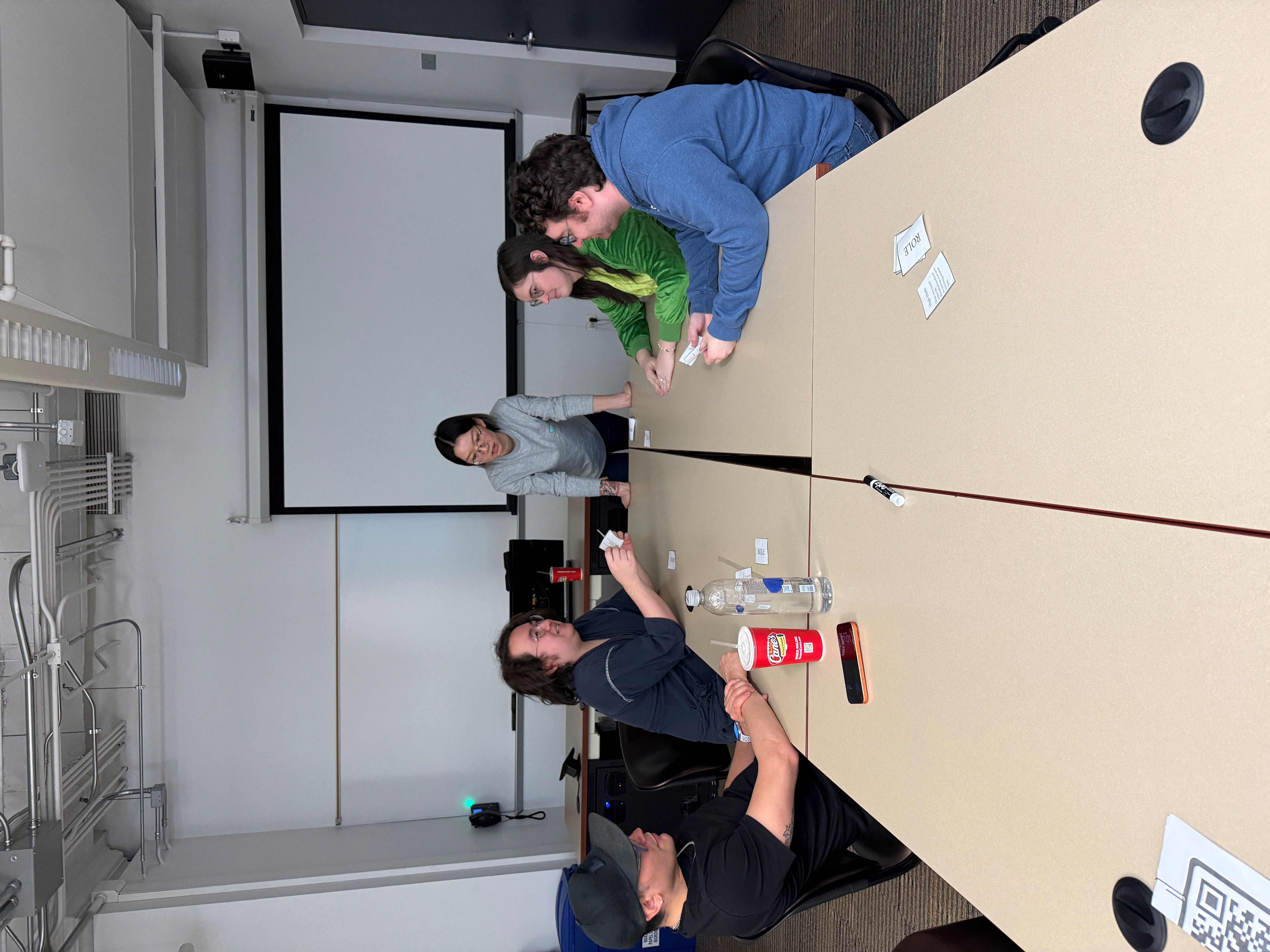
Playtesters trying on “V3” rules variation of Mr. President Duck
This version of the game did not feel as fun to play. It had potential, but in order to dig deeper into what could make this version interesting it’s a lot of investment we cannot afford (we’re already at risk of going over our (nonexistent) budget). But it’s good to try anyways. You can think about the rules of the game and how interactions can play out theoretically all meeting, but you never know if it’s actually good and fun until you do the playtest. So always do the playtest, even if you’re scared people are gonna say it’s bad. Better to know now rather than later.
Okay, that’s all for me! Tune in next time for when I actually get around to a thing that I said I was gonna talk about the last two posts (will it actually happen? Who knows! No, really, even I don’t know (but maybe it will be for real this time). Special thanks to honorary agents José, Valorie, and Kai for putting up with us in the meeting room and playtesting these versions.
Anyways, I need to prepare the print and play sheets for the upcoming playtest. Before we end this post, we have one more thing. Please, take a look *Nintendo Switch snap effect*
Art
Nyah, pipe down ya chumps. We’s here ta rustle a few tail feathers, knowwhaddamean?
Fuggidaboudit. Ya’see, me n’ da bosses had a bit of a billwag, ya’see? I tells ya, things’re gonna be different round here. We knows who the target is now, they’s out in the open, I tells ya. Sittin’ duck. Them federales mooks ain’t got a chance. We got ’im right where we wants ’im. Just gotta blend in proper-like, then they’s done for, I tells ya, fuggidaboudit.
Now it ain’t gonna happen overnight, not if ya mooks laze around. So get ta work! We’s heard tella da target changin’ whens we get a good hit on ‘im. Not sure how dat’s happenin’, but eventually, if we’s hit ’im very hard, we’s get ’im, knowwhadamtalkinbout?
If ya needs a lil’ morale boost or what have ya, fuggidaboutit, I gotcha covered. We’s in the Art Department requisitioned a shiny new paintin’ tablet this week! Thing’s the bees knees, I tells ya! Now all we’s gotsta do is wrap our beaks around how ta use it, and we’s in bidniss, fuggidaboudit!
I’m includin’ some slides with ya new tools a da trade at the end here, ya’see? Now I know somea yous mooks might be tempted ta eat ’em, but they ain’t for eatin! Least not by yous. But take a gander, so’s you know’s what not ta eat.




Ok, get back ta work ya lazy sonsaducks!
-Transcript of a slideshow by Sammy “Da Goblin” Malone